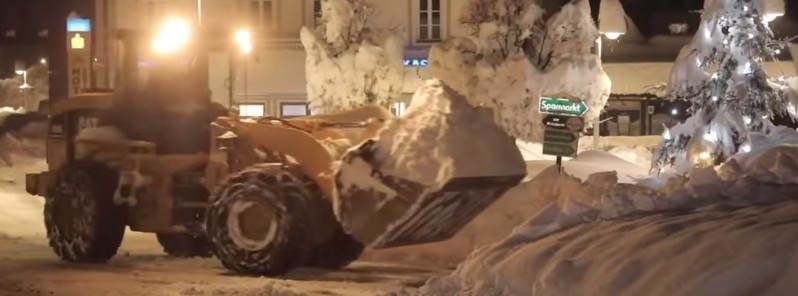Major winter storm buries parts of Alps under more than 3 m (10 feet) of snow, Europe

A major winter storm that started affecting parts of Europe on Friday, December 4, 2020, has dumped more than 3 m (9.8 feet) of snow in parts of Italy and Austria by the end of December 6 and more than 770 mm (30 inches) of rain in the town of Barcis in northern Italy. The snow is still falling, with up to 80 cm (2.6 feet) more expected in the Dolomites, Italy, and Carinthia and Osttirol, Austria on Tuesday, December 8. Before the event is over, some parts of the Alps might end up under more than 5 m (16.4 feet) of snow.
The general pattern over the North Atlantic and Europe has changed as we entered the much more dynamic weather lately, Marko Korosec of the Severe Weather Europe said.
"A very deep upper trough/low has emerged into southwestern Europe while a persistent upper-level ridge is placed across western Russia and eastern Europe," Korosec explained.
"In between, a powerful southerly jet stream is advecting high moisture towards the north. A significantly warmer air mass is being pumped from the Mediterranean into Central Europe and the Alps. While at the surface, a deep secondary low is emerging over Italy."
"This has introduced a textbook scenario for extreme rainfall and snowfall for the Alpine region, precisely across northeast Italy, south Austria and northwest Slovenia."
A combination of excessive rainfall, snow melting, and snowfall at higher altitudes could lead to damaging flooding and avalanches in the region, Korosec said Friday, December 6. Sadly for the region, Korosec was spot on.
Most of the snow fell on Sunday, December 6, bringing widespread disruption and travel chaos, with flooding at lower levels and power lines down in places.
3m of new snow across some southern parts of the Alps and it hasn't finished yet! https://t.co/PGoKdcOhGN pic.twitter.com/56qtH2bY7r
— weathertoski (@weathertoski) December 7, 2020
Over 2 metres of snow fell across the Alps over the weekend. Avalanches occurred in the Tyrol region of Italy and residents needed to shovel the heavy snow off their roofs!#weatherandradar #alps #italy #austria #snow #avalanche pic.twitter.com/03RwX4ApXK
— Weather & Radar International (@wr_int) December 7, 2020
Ab 6:30 h von mir wieder Liveupdates aus Heiligenblut: https://t.co/Y4juUiEXhm pic.twitter.com/0viRuNbwLi
— Alois M. Holzer (@alois_holzer) December 6, 2020
Deep snow in Folgarida, Alps, NE Italy this morning, Dec 7th. Thanks to Fabio Tamburini for the report – posted with permission. pic.twitter.com/pdjuyxaiJl
— severe-weather.EU (@severeweatherEU) December 7, 2020
After an intense snowstorm and ice storm just a few days and tons of rain yesterday, today produced several severe storms over the Adriatic Sea. Including a supercell storm in the evening with a tornado into the port of Trieste. Beyond EPIC! Never.Stop.Chasing! Marko Korosec pic.twitter.com/aXquUY8Q8O
— Marko Korosec (@MarkoKorosecNet) December 7, 2020







Italy's Ministry of the Interior reported on December 6 that the regions of Veneto, Friuli Venezia Giulia, Emilia-Romagna, Piemonte, Lombardy, and Tuscany were all severely affected, with 2 fatalities already reported in Lombardy and Basilicata.
Fire service reported 2 500 interventions from December 5 to 7, with most of them in Veneto (1 000), followed by 300 in Emilia-Romagna.
\The worst of the flooding took place along the Panaro river in Modena Province of Emilia-Romagna region. Residents of Nonantola were reportedly affected particularly bad — with 175 people rescued from the flooding. In total, 364 people in the region were evacuated.
The flooding and rescue operations in Nonantola continued into December 7.




Mudslides, avalanches, torrential rain, and rivers breaking their banks turned the first weekend in December into a nightmare and brought much of the country to its knees, ANSA reported.
The town of Barcis in the Pordenone Province recorded more than 772 mm (30 inches) of rain since the start of the event — the heaviest in 30 years.
Veneto and Trentino in the far northeast suffered avalanche alarms, while roads and rail links were interrupted by heavy snow and flooding, ANSA reported.
A fire vehicle crashed into a torrential stream near Bologna and the fire team had to be rescued after a bridge gave way.
Rome was lashed by thunderstorms and torrential showers, and access to the Tiber banks was shut after the river neared dangerously high levels.
The Brenner Pass, which had been closed on Sunday after more than 90 cm (2.9 feet) of snow fell, was reopened to traffic on Monday.
Featured image credit: WetterOnline

Shame Europe is getting buried under snow.
I live in a northern state in the USA and we’ve had the warmest fall on record. We have not had a real winter in 10 years. A white Christmas is just a faint memory. It’s a long dark fall followed by an early & muddy spring at Groundhog Day.
Yesterday, or in less than 24 hours before this major storm, the European scientists reported that November’s global temperatures were the highest ever, surpassing the previous record, set in 2016 and 2019.
https://www.nytimes.com/2020/12/07/climate/climate-change-hottest-november.html
Man-made global warming, man-made global warming, I need your money to stop global warming Hahahahahahahahahaha